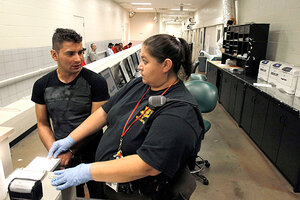Obama as border cop: He's deported record numbers of illegal immigrants
New data suggest that the dramatic rise in deportations for illegal immigrants since 9/11 has continued under President Obama, hitting record levels in 2009.

A suspect (l.) in Phoenix is fingerprinted by a Maricopa Country sheriff's detention officer on July 26 to check his immigration status. The federal government is rapidly expanding a program to identify illegal immigrants using fingerprints from arrests.
Ross D. Franklin/AP/file
Tucson, Ariz.
A parade of states led by Arizona says the federal government is not doing enough to combat illegal immigration. But by one measure – deportations – the federal government is doing more than it has ever done.
In 2009, the United States deported a record 387,790 people – a 5 percent increase over 2008. Nearly two months before the end of the 2010 federal fiscal year, the deportation rate is down slightly from 2009, but the number of removals is still likely to be more than triple what it was in 2001.
The numbers come from a recently released study by Syracuse University in New York. Among the other significant findings: An increasing share of deportees are immigrants who have been convicted of a crime, reflecting President Obama's desire to reorient the deportation process toward targeting criminals.
Critics of Mr. Obama worry that the focus on criminals could mean a pass for most noncriminal illegal immigrants. They also note that deportation alone does not represent a comprehensive immigration policy. But the deportation trend does run counter to many perceptions in border states and beyond about federal anti-illegal immigration efforts.
“We have never, ever deported so many people from the country as we are doing now,” says Douglas Massey, an immigration expert at Princeton University in New Jersey.
The only other time deportations came close to existing levels was in the early 1930s, during quasi-official deportation campaigns against Mexicans. Expulsions peaked at 136,000 in 1931 and "were done primarily by local officials and don't show up in federal statistics on deportations,” Professor Massey says.
Behind the rise: 9/11
The current deportation boom began in the mid-1990s and accelerated after the 9/11 attacks. Since coming into office, Obama has begun to recast this trend.
In 2008 and 2009, for instance, the majority of removals were people who had not been convicted of any crime, according to US Immigration and Customs Enforcement (ICE) data. Through Aug. 2, 51 percent of the 294,230 people deported or forced out this fiscal year were convicted criminals.
The report by the Transactional Records Access Clearinghouse at Syracuse is based on ICE data. It comes as the Obama administration endures strong criticism from state lawmakers and conservative pundits who say the federal government has done little to clamp down on illegal immigration and to secure the border.
In April, Arizona Gov. Jan Brewer signed a law that required local police, during the course of their normal duties, to determine the immigration status of potential illegal immigrants. Last month, a federal judge put this and other controversial parts of the law on hold, although some portions became effective July 29.
The Syracuse report is a rebuke to those backing Arizona-style laws, says Gregory Chen, director of advocacy for the American Immigration Lawyers Association: “It’s a perfect example of how those allegations are based really only in politics.”
Obama too focused on criminals?
But others say the Syracuse report doesn't tell the full story. Removals may be on the rise, but they are not enough to rein in illegal immigration, says Ira Mehlman, a spokesman with the Federation for American Immigration Reform.
“The problem isn’t just criminal aliens, it is a general lack of respect for our laws, and even noncriminal aliens do have a significant impact on state budgets, on unemployment, on all sorts of things.”
Mr. Mehlman says the efforts to remove criminals is a tactic designed to promote an eventual amnesty for illegal immigrants who don’t commit crimes.
The report, however, suggests that a focus on criminals does not necessarily lead to a criminals-only policy. The report singles out the Secure Communities program – which relies on fingerprints from arrests – as one way the federal government can cast a wider net. The program targets not just suspects in serious crimes such as homicide, kidnapping, and sexual assault but also those arrested for traffic violations and a variety of other minor offenses.
The database-driven program is “a very large contributor to the increase in criminal aliens ICE has identified,” says Vincent Picard, an agency spokesman.
Secure Communities was launched in October 2008 and plans are to implement it in every jail by 2013.
Some say the continued rise in deportations may be Obama’s way of trying to win over critics and make his version of comprehensive immigration reform more palatable to opponents.
“The administration is trying to gain credibility – with enhanced enforcement, troops to the border, and by other measures – to make clear it is taking action on immigration,” says Jack Chin, a University of Arizona law professor.
